After launching the micro iDSD Black Label Edition, whose high technological level and multitude of possibilities come on top of using active and passive audiophile-grade components, and which seems to be the ultimate edition of the micro iDSD, its high-end portable DAC, the English manufacturer iFi Audio has just begun marketing the nano iOne, which positions itself as an entry-level portable DAC.
But this number One DAC has inherited from, on one side, the technology that equips all the previously cited models, as well as other iFi Audio devices, including the Femto precision clock system and the Active Noise Cancellation® (for the power supply). The nano iOne DAC is also fitted with the DSD1793 conversion chip from Burr Brown Japan included in the other iFi Audio models.
There’s no Headphone Jack on this DAC, only one fixed level stereo audio output, a choice of two digital filters and two digital inputs—one USB B and one coaxial S/PDIF—and also an aptX Bluetooth connection that will allow you to use it wirelessly with a compatible device (a smartphone, a tablet or even a PC). This DAC will make your life easier and can be trusted in the hands of many people.
Presentation It’s a makeover at iFi Audio with the iOne DAC, because it has been created by a former Stark designer. It is still an extruded aluminum compact box with a top side presenting a horizontal plane and two slightly inclined planes reaching the lateral sides, while the front and back sides fit this section of the box and do not stick out like the previous products.
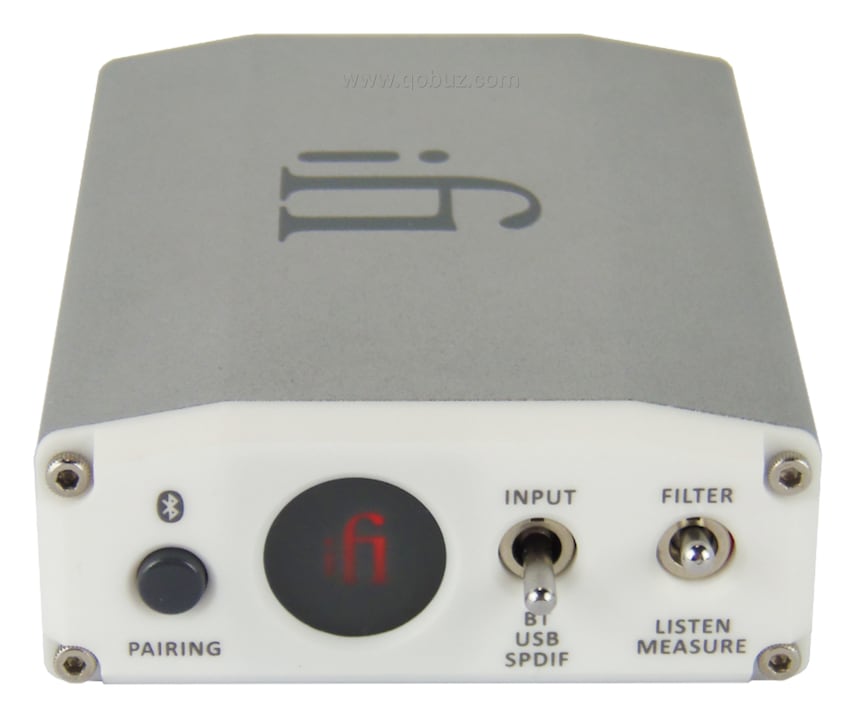
A white plastic material has been chosen to create the front and back sides, in order to facilitate the capture of the Bluetooth signals by the internal receiver, each side of the box being also a little window closed by a translucent plastic piece that lets the signals go in and the light from the internal LED go out, whose color changes depending on the source selected with the toggle switch labelled Input (blue for Bluetooth, green for USB and red for S/PDIF) and which illuminates the backlighting iFi logo located in the facade window.
Another switch allows to choose between two filters, one recommended for listening (minimum phase filter) and the other one more suited for measurements (standard filter), and finally a little pushbutton switch that enables the Bluetooth pairings.
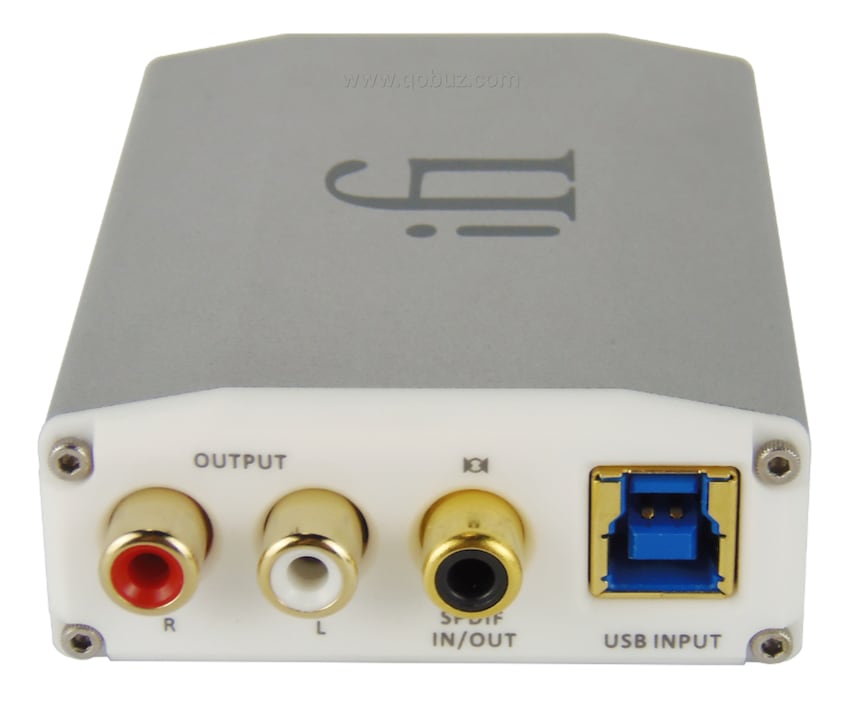
In the back, the connectivity is stripped down to the essentials, a type B USB3 input, a digital coaxial S/PDIF combining coaxial and optical—working as both an input and output (in USB and Bluetooth)—and the RCA analog stereo outputs.
Manufacturing
On the top side of the circuit board, you’ll find the connectors, the switches and the pushbutton, miscellaneous components, and also the antenna for the Bluetooth module, as well as the USB card horizontally plugged in the connector of a little card planted on the mainboard, where is also located the multicolor LED indicating the selected source.
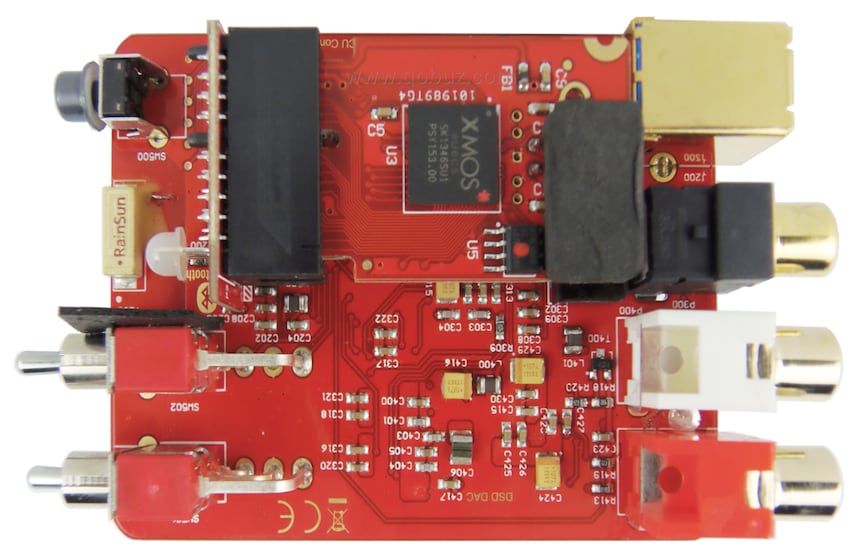
The USB processor is a XMOS 8U6C5 model compatible with PCM digital audio signals up to 32 bits at 384 kHz, and also DSD signals. It also handles the coaxial S/PDIF input which uses an impedance converter offering a galvanic isolation (without common potential).
The other side hosts other strategic components, starting with the Bluetooth module, a JX219 by the manufacturer Jingxunsoft. You can also see the STC microcontroller, as well as the Femto precision clock system set around the U300 integrated circuit (unidentifiable).
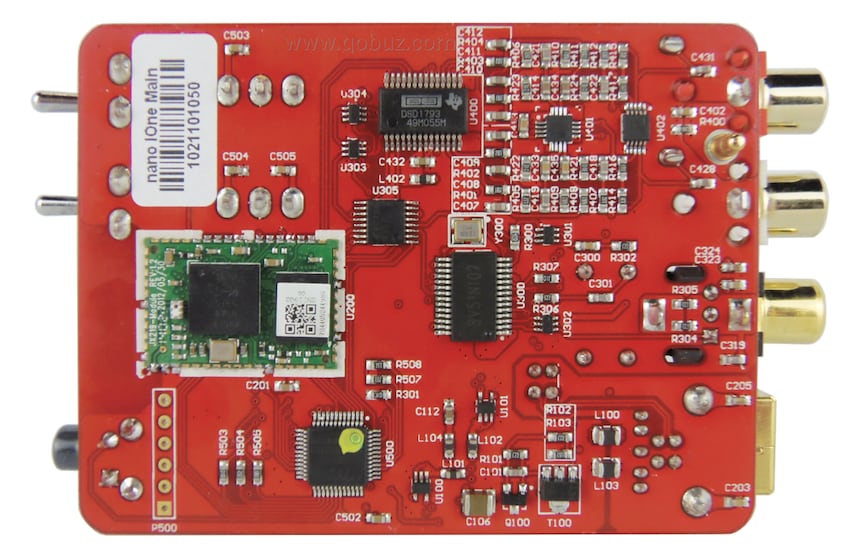
Then, you’ll find the digital-to-analog conversion chip, a DSD1793 model developed specially by Burr-Brown Japan, able here to decode PCM digital audio signals sampled up to 384 kHz, and DSD signals up to 12.4 MHz. Last, the active filter is built around a Maxim Max97220A operational amplifier (of excellent quality).
As for the power supply, it uses the Active Noise Cancellation process that you can find in other devices from the brand and which, as implied by its name, works by actively, and not passively, cancelling the noise. You can see it in the bottom right corner of the picture.
Sound
Knowing the sound quality of the iFi Audio DACs, we would have been really surprised to find out that the nano iOne didn’t fall in line with the other products from the family, especially since it reuses part of the electronic components that equip other devices from the brand, and that the operational amplifier used in the active filter after the conversion is actually a headphone amplifier whose excellent musical qualities have been verified time and time again in our tests.
To better get a feel of the sound quality of this nano iOne DAC, we have started our tests by linking the device to a class A NuForce HA-200 headphone amplifier and launched on the new Qobuz Desktop the beautiful interpretation (in Hi-Res 24 bit/88.2 kHz) of Monteverdi’s Vespers for the Blessed Virgin by La Compagnia del Madrigale and the ensembles Cantica Symphonia and La Pifarescha conducted by Giuseppe Maletto, album which moreover benefits from an excellent sound recording, adding to the overall enjoyment!
And here, we reach an intense musical happiness, because the nano iOne delivers a fantastic sound restitution, and we take the time to listen time and time again the superb introduction to this work Versiculum et responsorium : Domine ad adiuvandum, turning up the volume (it’s a clear sign that we love, or even adore, the music and its reproduction), as the iOne perfectly restitutes the brass instruments without any digital artifice, and where the choir and other instruments fill up the space with equal magnificence and ease; nothing seems forced, and the naturalness and sonic quasi-truth shows through at every moment. There’s no mistaking our ears.
As for listening through the aptX Bluetooth connection, it is of course possible with a smartphone or a tablet equipped with this encoding system, but we were pleasantly surprised to find out that iFi Audio had included the aptX codec in the driver installation software on PC, which allowed us to not use the Harmony software that we usually employ with the Avantree DG40 Bluetooth dongle.
We weren’t the most lenient when testing the sound quality of this connection, because we chose to listen to the Allegro moderato from Tchaikovski’s Violin Concerto, in the iconoclastic and unconventional performance of Patricia Kopatchinskaja on violin with the ensemble MusicAeterna conducted by Teodor Currentzis.
We’ve listened to this version several times already, and the nano iOne DAC offered a faithful restitution of what we were used to hear, i.e. the exacerbated playing from the violinist—who sometimes literally scratches the cords of her instrument—as well as the colors of the orchestra, with diving trebles and dynamic musings that the iOne had no difficulty reproducing. In one word, we enjoyed it a lot!
Still using the aptX Bluetooth connection, we listened to the Bee Gees’ album Size Isn't Everything, another one of our favorites. Nothing to say, the reproduction is of the highest quality, precise and without excess, and the large bandwidth has an excellent bass stability while the guitar chords from Blue Island run so well that you’re compelled to turn up the volume.
Using the device on coaxial with our Sony UDA-1 amplifier and our Triangle Antal Anniversary speakers, the musical enjoyment provided by the iFi Audio nano iOne DAC is once again exemplary and the reproduction of titles such as My Sweet Lord and Isn't It A Pity from George Harrison’s album All Things Must Pass reveals all the musical richness and emotion conveyed by those tracks, with guitar chords of an extreme subtlety and a feeling of global coherence and balance. It is also worth noting that we haven’t noticed any difference between the two digital filters during our listening session.
To conclude, it is true that this nano iOne DAC shares some quality components with other iFi Audio devices that we’ve awarded in the past, and we also bestow it with our Qobuzism award for its high musical performances, its ease of use and the addition of a aptX Bluetooth connection to the USB and S/PDIF connections.
Elite Diffusion Website (importer)
Playback capabilities

Erratum: we failed to notice this, and furthermore we didn’t know about that fact, but the iOne DAC’s coaxial S/PDIF input is a combined electrical and optical model, and as such can be used with an optical 3.5 mm Jack connector. For that matter, a Toslink-optical 3.5 mm Jack adapter is supplied by iFi Audio with the iOne to use this input with a standard Toslink optical cable.
We have performed our usual review procedures with this optical input and have recorded the results in our data table. We would like to apologize to iFi Audio and to our readers for this error.
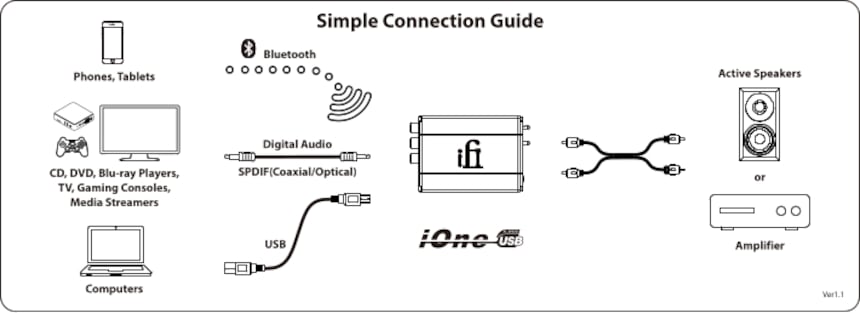
To follow everything that happens on Qobuz, join us on Facebook!
If you are a manufacturer, importer, retailer or key player in the digital music industry and wish to contact us, you can do it through the following email address: newstech@qobuz.com
If you’re enthusiastic about the Hi-Fi Guide column and wish to contact us, you can do it through the following email address: rubriquehifi@qobuz.com


